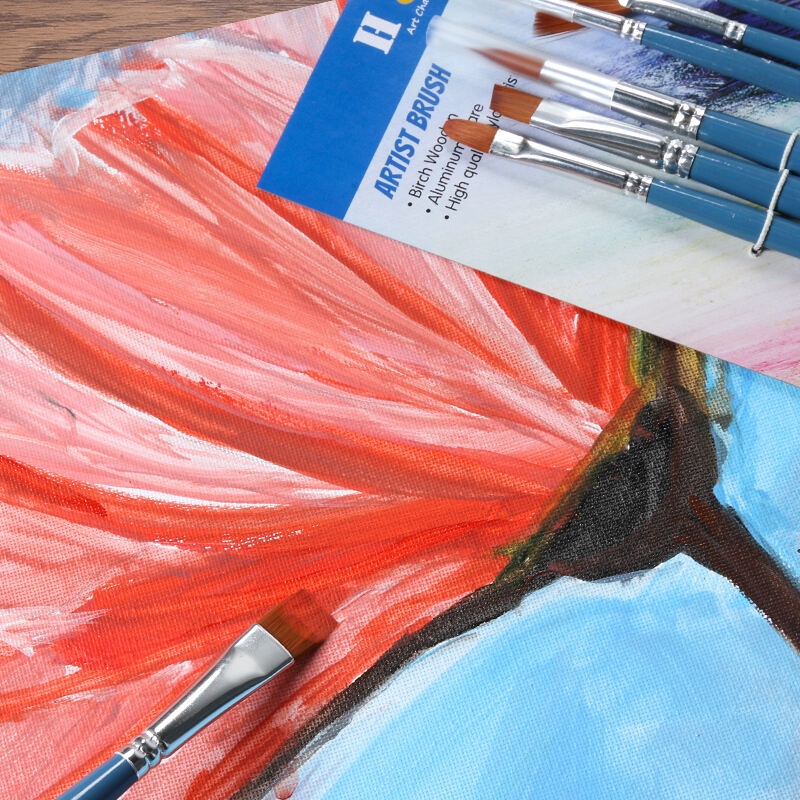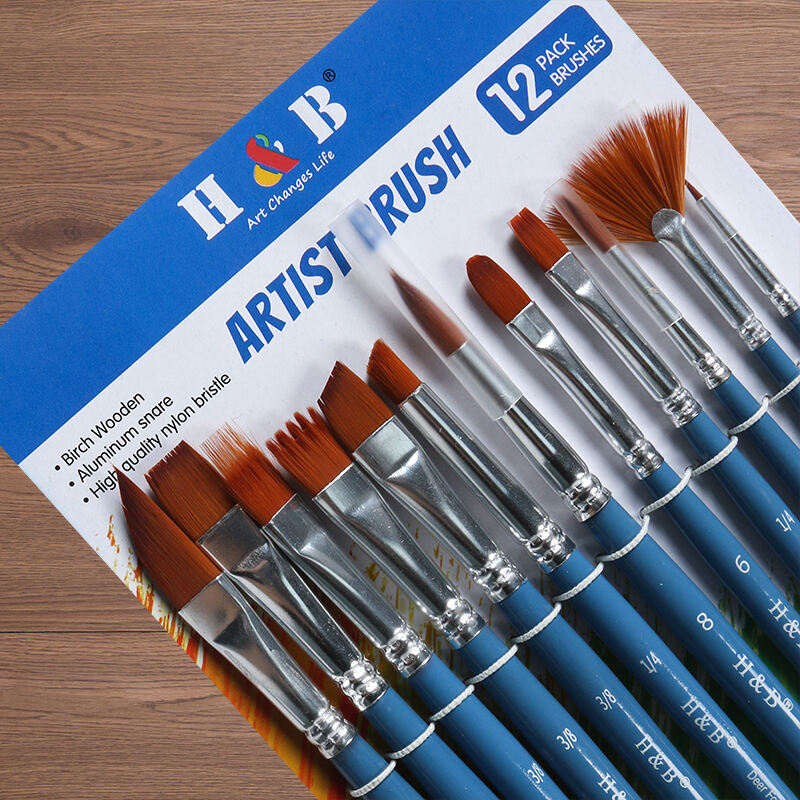Core Traditional Drawing Tools and Techniques
Graphite Pencils: Versatility in Line and Shading
For artists, graphite pencils just can't be beat when it comes to versatility. They come in all sorts of hardness grades ranging from super hard 9H down to the soft black 9B pencils. This whole range lets artists play around with different line weights and shading effects, something really important for those detailed techniques like hatching and cross-hatching work so well with graphite. What matters most though is the actual quality of the graphite inside. Better quality pencils give much smoother lines without breaking or smudging as much, which makes all the difference when working on intricate details. Most artists use them for quick sketches but also rely on good graphite pencils for final drawings too. According to some recent surveys, roughly seven out of ten artists list graphite pencils right at the top of their must-have drawing supplies, showing just how central these simple tools remain in artistic practice today.
Erasers: Precision Tools for Controlled Adjustments
Erasers play a really important role in drawing, not just for fixing mistakes but also creating special effects. There are all sorts of erasers out there, each good for something different. Take those tiny precision ones, they let artists fix little boo-boos without tearing up the paper. Artists often use them to bring back light areas in graphite drawings too, which makes a big difference in how the finished piece looks. According to what many artists say, around 60% think erasers are part of their basic toolkit, showing these tools matter way more than just correcting errors. The fact that erasers come in so many forms means they help with everything from fine detail work to making the whole artwork look better overall.
Paper Quality: Foundation for Artistic Execution
What kind of drawing paper someone picks really matters because it changes how the final piece looks and lasts. Smooth versus rough surfaces work better for different styles of art, letting creators get their ideas across just right. Acid free stuff? That's actually pretty important stuff for keeping artworks looking good years down the road. Museums and conservation groups back this up after all their research on preserving art. Better quality paper makes blending colors and building layers much easier, no matter if someone draws just for fun or makes a living at it. Good paper isn't just about aesthetics though. It forms the base that lets artists reach higher levels of skill while knowing their work won't fade away too quickly when hung on display.
Exploring Different Drawing Mediums and Their Effects
Charcoal: Expressive Depth and Textural Contrast
Charcoal stands out because it creates those amazing dark areas and striking contrasts that just pop off the page, which is why so many artists reach for it when they want something really expressive. What makes charcoal so great? Well, artists can play around with all sorts of methods - smudging here, layering there - and end up with everything from light grays to deep black shades that give their work real dimension. The way charcoal blends so smoothly means artists can move between light and shadow without any harsh lines, no wonder about 55 percent of folks trying out different materials keep coming back to charcoal again and again. And let's not forget how well it shows texture differences, something that's super important for portraits or landscapes where capturing mood matters most.
Ink Pens: From Technical Precision to Fluid Expression
Artists really love ink pens because they come in so many different forms. Fine liners give that sharp detail while brush pens let creators go wild with bold, flowing lines. Ink stays put once it hits paper, which makes artworks look stronger and more dramatic something most artists appreciate when they want their work to stand out. But there's a catch here too. Since mistakes stick around forever, artists need to think things through before putting pen to paper. Some folks actually draw faster with ink pens according to recent polls among creatives. Those same polls found people who sketch regularly with ink produce about 40% more work overall probably because everything shows up right away without needing corrections later on. That tension between careful preparation and spontaneous creativity keeps many artists coming back to ink again and again despite all the potential headaches.
Conté Crayons vs Pastels: Tactile Mark-Making Choices
The feel of Conté crayons versus pastels makes all the difference for many artists working on their pieces. Conté sticks have this dense consistency with cores that let colors mix in ways that make detailed work possible, kind of like getting the best parts of both drawing and painting into one medium. Soft pastels tell a different story entirely though. They pop with color and blend beautifully across surfaces, but just don't offer the same level of control as Conté does for finer details. Artists tend to gravitate toward one or the other depending on what they need for a particular piece. Some folks actually keep both around because studies indicate around two thirds of professional artists do exactly that, switching tools as projects evolve. For those who want intricate textures from Conté or bold statements from pastels, these materials definitely expand creative possibilities beyond what standard supplies can achieve.

Digital Transformation in Artistic Expression
Tablets vs Traditional Media: Bridging Analog and Digital
Graphic tablets give artists something real to touch, almost like working with regular pencils and paper, making these devices pretty cool bridges between old school art and digital stuff. For folks used to sketching on physical surfaces, switching to tablets feels much more natural than staring at a mouse pointer all day. Most styluses today can sense different pressures applied during drawing, letting creators adjust line weights just like they would with varying pencil strokes. According to recent numbers from industry reports, around 56 percent of artists now favor digital workspaces because they're just so convenient and packed with features that weren't possible before. Many professionals actually argue that digital tools have become better choices overall for contemporary creative work, especially when considering what's available compared to traditional methods.
AI Art Tools: Collaborative Potential in Creation
Artificial intelligence tools are changing how people create art today. They help generate ideas and even build whole pieces from scratch, sparking debates about what counts as real creativity or authentic work. Many artists find these tools actually boost their own creative abilities, showing them fresh perspectives they might never have thought of otherwise. But there's still plenty of questions around who gets credit when machines play a role in the process. Recent surveys show that roughly 40 percent of artists now use some form of AI during their work, suggesting that tech assisted creation is becoming more accepted across the industry. Finding the right mix between machine generated content and human touch continues to expand what's possible in art while creating exciting opportunities for collaboration between creators and their digital counterparts.
Quality and Material Choices in Art Creation
Student vs Professional-Grade Material Impact
What kind of materials artists use makes all the difference when it comes to how good their finished pieces turn out. The pro stuff just works better because it has more pigment packed into it and stays consistent across batches. This means paintings last longer and look much richer on display. Teachers have noticed something interesting too. When kids get their hands on decent materials, they actually start getting better at what they do. Their confidence grows as they understand techniques more deeply. A recent poll found that around two thirds of art teachers tell serious students to spend money on proper supplies instead of settling for cheaper options. Getting those nicer materials lets young artists try different approaches without worrying about running out or colors fading fast. Most importantly, it helps them push their boundaries and create work that feels truly refined rather than just okay.
Longevity Considerations: Acid-Free Papers and Pigments
Artwork needs acid-free materials if we want it to last without deteriorating and keep those colors looking vibrant years down the road. What these materials do is stop things from fading away and prevent the actual structure from breaking down, which means the artist's work stays intact for much longer. Art conservation groups have done studies on this stuff, and they show pretty clearly that pieces made with proper materials can survive many more decades than those stored improperly. Around 8 out of 10 professional artists actually care deeply about how long their materials will last, because they know good quality protection matters for keeping their work around for people who come after them. When artists pick acid-free papers and pigments, they aren't just making a random decision—they're planning ahead so their creative efforts stand the test of time.
Tool Selection Strategies for Specific Art Styles
Getting the right tools makes all the difference when trying to pull off certain art styles. Different styles need different stuff really. Watercolor artists grab those big soft brushes for washes while illustrators reach for fine liners when they want details. Knowing what works best with each medium helps artists plan better and match their tools to what they actually want to create. Some recent studies show interesting results too. Artists who pick their materials carefully according to their style tend to see about 30 percent more impact from their artwork. Using the proper equipment does more than just make things technically accurate though. It actually boosts creativity as well, letting the true character and subtleties of whatever style someone chooses come through much clearer.
FAQ Section
What are the different hardness levels of graphite pencils?
Graphite pencils range from 9H (hardest) to 9B (softest), allowing artists to create lines and shades with varying intensity.
Why are acid-free papers important in art creation?
Acid-free papers are essential as they prevent artwork from deteriorating over time, ensuring longevity and preserving color vibrancy.
What are the benefits of using professional-grade art materials?
Professional-grade materials offer superior pigment concentration and consistency, resulting in richer and more durable artworks.
How does digital art software like Photoshop impact artistic processes?
Digital art software expands creative possibilities by offering tools for complex compositions and iterative designs, reshaping traditional techniques.


